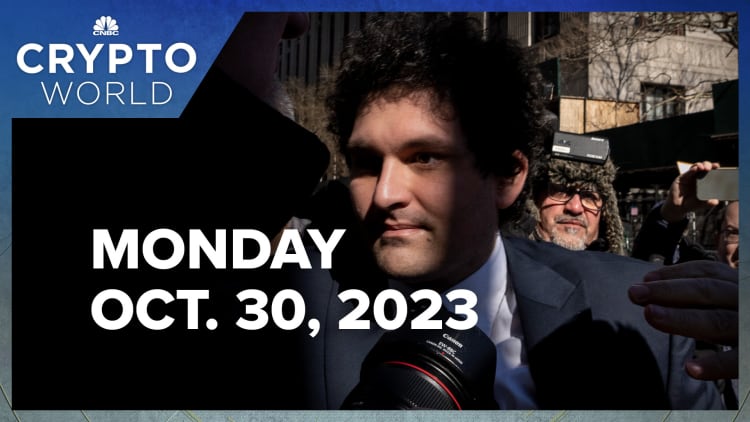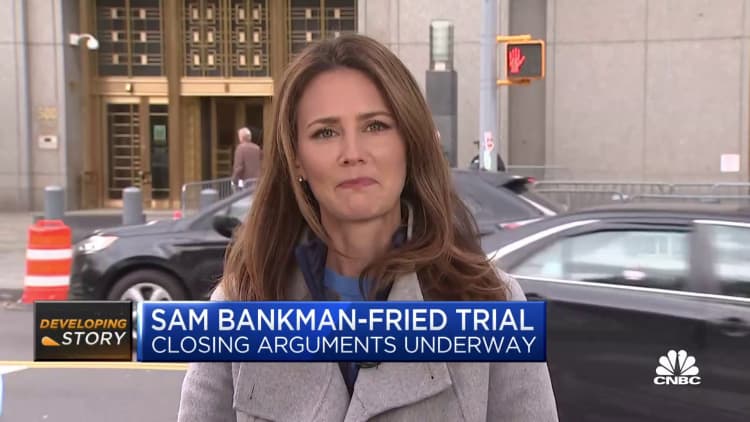[ad_1]
FTX Founder Sam Bankman-Fried leaves Manhattan Federal Court after a court appearance on June 15, 2023 in New York City.
Michael M. Santiago | Getty Images
Prosecutors in Sam Bankman-Fried’s criminal fraud trial kicked off their closing argument on Wednesday, reminding the 12 jurors why they’ve spent the past four weeks sitting in a lower Manhattan courtroom.
“Almost a year ago, thousands of people from all over the world who deposited money with FTX started withdrawing funds,” Assistant U.S. Attorney Nicolas Roos told the court.
Roos said there’s “no serious dispute” that $10 billion in customer money that was sitting in FTX’s crypto exchange went missing, with some of it going to to pay for real estate, investments, loan repayments and political donations.
The main thing the jury has to decide, Roos said, is whether Bankman-Fried knew that taking the money was wrong.
“The defendant schemed and lied to get money, which he spent,” Roos said.
Bankman-Fried, the 31-year old son of two Stanford legal scholars and graduate of Massachusetts Institute of Technology, faces a potential life sentence if convicted on charges, which include wire fraud, securities fraud and money laundering, all tied to the collapse late last year of FTX and sister hedge fund Alameda Research. He pleaded not guilty.
The trial, which began in early October and is set to wrap up in the coming days, has largely pitted the testimony of Bankman-Fried’s former close friends and top lieutenants against the sworn statements of their former boss and, for many of them, former roommate.
The government’s key witnesses included Caroline Ellison, Bankman-Fried’s ex-girlfriend and the former head of Alameda, and FTX co-founder Gary Wang, who was Bankman-Fried’s childhood friend from math camp. Both pleaded guilty in December to multiple charges and cooperated as witnesses for the prosecution.
FTX founder Sam Bankman-Fried is questioned by prosecutor Danielle Sassoon (not seen) during his fraud trial over the collapse of the bankrupt cryptocurrency exchange at federal court in New York City, U.S., October 31, 2023 in this courtroom sketch.
Jane Rosenberg | Reuters
When it was time for Bankman-Fried’s team to mount a defense, lead counsel Mark Cohen left the bulk of the case to his client, who spent three days on the stand telling the jury that he didn’t defraud anyone, didn’t take customer money and tried to work with his deputies to keep FTX from failing.
Roos spent Wednesday morning asking the jury to look at the evidence. At one point, he asked, “Who is responsible? He then stepped out from behind the podium and towards the defense table, pointed at the defendant and said, “This man, Samuel-Bankman-Fried.”
“A pyramid of deceit was built by the defendant,” Roos said. “That ultimately collapsed.”
The facts, as listed by Roos, were that customers believed their deposits were their own and not to be used by anyone else; that FTX ads continually said the exchange was the safest and easiest way to buy cryptocurrency; and that $10 billion was missing.
‘Uncomfortable to hear’
Roos told the jury that Bankman-Fried lied to them, reminding them how smooth the defendant was in answering questions from his own attorney but how “he was a different person” when it was the prosecutors’ turn. He had a perfect memory on Friday, Roos said, telling the jury that Bankman-Fried knew the details about the layout of his Airbnb office in California, the reason he went to Hong Kong and why he picked the Miami Heat arena as the one for FTX to sponsor.
That all changed when the government was asking the questions.
“It was uncomfortable to hear,” Roos said, adding that Bankman-Fried said “I can’t recall” over 140 times during questioning by the government.
“To believe his story, you’d have to ignore the evidence,” Roos said. “You’d have to believe the defendant, who graduated from MIT and built two multibillion-dollar companies, was actually clueless.”

Critical to the failure of FTX was the use of customer funds to cover losses in Alameda’s books following the plunge in crypto prices last year. Roos said Bankman-Fried is the one who gave special privileges to Alameda, which he started before founding FTX, allowing it to siphon customer money. He knew it was wrong, Roos said, which is why he kept it secretive.
Roos said Bankman-Fried had been lying to the public about Alameda’s “secret advantages,” and was being untruthful when he told the public and the media that Alameda was just like everyone else.
“Those were lies,” Roos said. Had they known the truth, “investors would have run for the exits,” he said.
Bankman-Fried blamed “messy accounting,” Roos said, adding “give me a break.” He said those comments contradicted what he told Congress, that he’d reconciled the books.
Judge Lewis Kaplan, who presided over the trial, started court almost a half hour late on Wednesday because a juror was stuck in traffic. Then there were technical issues, as the second row of monitors in the jury box stopped working. That led to a 1- minute break.
Later in Roos’s closing, he brought up the infamous spreadsheet of the seven alternate versions of Alameda’s finances that Ellison had put together when third-party lenders were asking for an update. Bankman-Fried testified that he’d seen a spreadsheet but didn’t remember the details and didn’t ask Ellison questions about it. Roos called the explanation “implausible.”
FTX founder Sam Bankman-Fried is questioned by defense lawyer Mark Cohen as he testifies in his fraud trial over the collapse of the bankrupt cryptocurrency exchange, at federal court in New York City, U.S., October 30, 2023 in this courtroom sketch.
Jane Rosenberg | Reuters
Roos referred to metadata showing that Bankman-Fried was part of a meeting for about 30 minutes where the hole in FTX’s balance sheet and repaying lenders were discussed. Metadata shows he was studying the Google Doc of the company’s finances, with numbers indicating the billions in borrowing from FTX.
Roos brought up testimony from three firsthand witnesses who said that they’d spoken with Bankman-Fried about the giant hole in the balance sheet. Ellison said there was no way to repay it, and Singh testified that Bankman-Fried admitted to him that “we are a little short on deliverables.”
Bankman-Fried “had the arrogance to think he could get away with it,” Roos said.
Spending freely
Another point speaking to the defendant’s intent, Roos said, was his tweeting.
Bankman-Fried’s plan last November, when he knew there was only enough money to process one-third of client assets, was to send a confident tweet thread. Singh testified that he wasn’t comfortable with the plan, yet Bankman-Fried went on to tweet that “assets are fine” as the bank run was underway, Roos said.
Bankman-Fried knew Alameda had a negative net asset value of $2.7 billion, Roos said, but wanted to make another $3 billion in venture investments. The only way to do that was with FTX customer funds, he said.
Additionally, Roos told the jury, client money went to $100 million in real estate expenses, including a $30 million penthouse in the Bahamas and $16 million for his parents’ home.
In referencing the Super Bowl picture with Katy Perry and others, Roos called Bankman-Fried a “celebrity chaser.”
Roos walked the jury through a timeline of key moments, as follows:
- On Sept. 1, Bankman-Fried saw that FTX had a $13.7 billion hole.
- On Sept. 7, Bankman-Fried wrote a long memo proposing the shutdown of Alameda. Still, he spent $45 million for a stake in Skybridge Capital.
- Then, on Sept. 22, he paid $4 million to himself.
- Four days later, he sent $250 million to Modulo Capital, a hedge fund in the Bahamas.
- And on Oct. 3, he funneled $6 million for political donations.
“That’s all you need to know to find him guilty,” Roos said.
CNBC’s Dawn Giel contributed to this report.
WATCH: Closing arguments underway in SBF trial

[ad_2]

